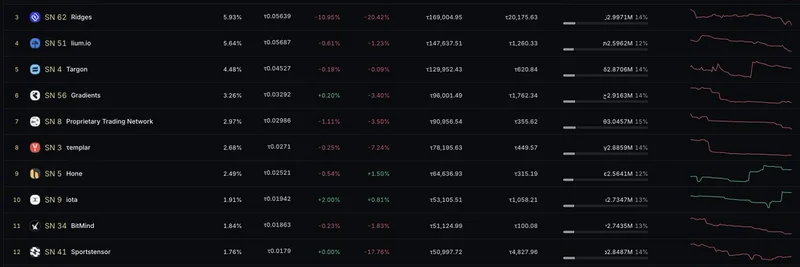In the fast-paced world of blockchain and crypto, new concepts pop up all the time, often blurring the lines between serious tech and hype-driven speculation. Recently, hitesh.eth (@hmalviya9) shared a detailed post on X about Bittensor's ($TAO) subnet alpha tokens, emphasizing that they're not just another meme play. If you're into meme tokens but looking to level up your knowledge, this is worth a read. Let's break it down step by step.
What Are Bittensor Subnet Alpha Tokens?
Bittensor is a decentralized network focused on machine intelligence, where "subnets" are specialized modules that contribute to the overall ecosystem. Each subnet has its own token, called an "alpha token," which represents value within that subnet.
According to hitesh.eth, there are currently 128 such subnet alpha tokens. These aren't your run-of-the-mill meme coins launched on Solana or Ethereum for quick pumps. Instead, they're tied to the Bittensor protocol's emission and staking mechanics. Tokens with the lowest emission rates risk getting delisted when new subnets enter the fray—always check the prune ranking to stay ahead.
To register a new subnet, you need to lock around 1.3K TAO. The price of each alpha token is determined by the ratio of TAO staked in the subnet reserve to the number of alpha tokens available. More staking and swapping TAO for alpha tokens drives the price up, which in turn boosts the subnet's share of the daily TAO emissions.
Market Dynamics and Upcoming Changes
The daily TAO emission is set to halve in the next two months, which could shake things up. Miners (those providing computational resources) will likely shift toward subnets with proven product-market fit and revenue streams to maximize returns. This isn't blind speculation—it's about sustainability.
On the flip side, communities around these subnets might hype up their alpha tokens, creating speculative demand. Think discussions on use cases, teams, and potential growth. While this can drive prices, it also attracts less informed participants, turning early adopters into potential exit liquidity providers.
hitesh.eth warns against FOMO: "If you are someone who is getting FOMO about entering the subnet ecosystem, it is not as easy as you think. These are not memes, and you cannot be passive when betting on them."
Why They're Different from Meme Tokens
Meme coins thrive on virality, celebrity endorsements, and community vibes—think Dogecoin or newer plays like $PEPE. But subnet alpha tokens demand real homework. You need to dive into docs, watch explainer videos, and engage with communities to grasp the underlying tech and value.
- Research Required: Unlike memes where a funny image or tweet can spark a rally, alpha tokens' success hinges on the subnet's utility and the network's health.
- Staking and Emissions: Prices are influenced by actual staking activity and protocol rules, not just social media buzz.
- Risk of Delisting: Low-emission tokens could vanish, adding a layer of strategy absent in most memes.
If you're new, stick to the top five subnets by emission to minimize risks. Don't chase shilled tokens without understanding the game.
Key Takeaways for Blockchain Enthusiasts
This insight from hitesh.eth highlights a shift in crypto: from pure speculation to informed participation. For meme token fans, it's a reminder that while memes are fun, ecosystems like Bittensor offer deeper opportunities—if you're willing to put in the work.
If you want to explore more, check out the original post on X and start researching Bittensor's official resources. Stay informed, and remember: in crypto, knowledge is your best edge.
For more on meme tokens and emerging blockchain trends, browse our knowledge base at meme-insider.com.


